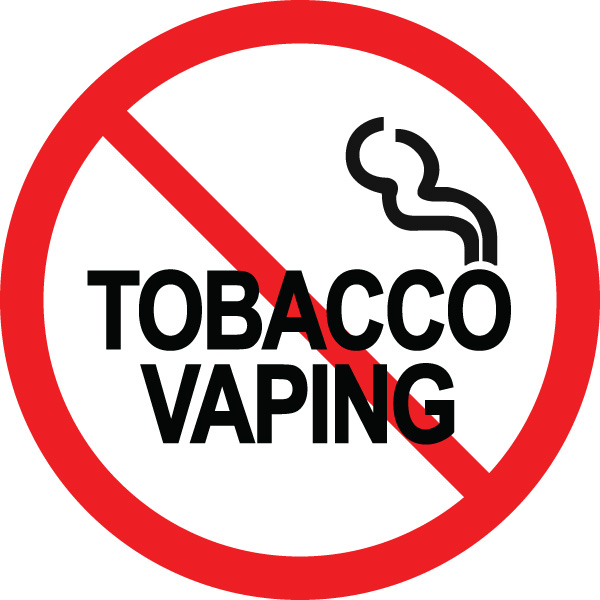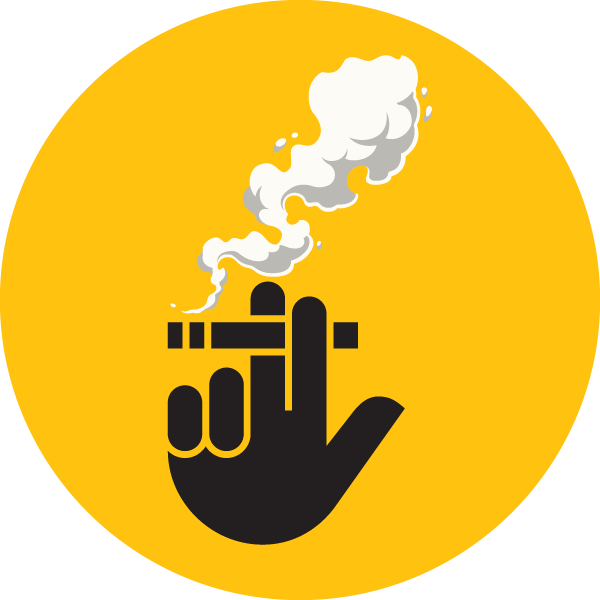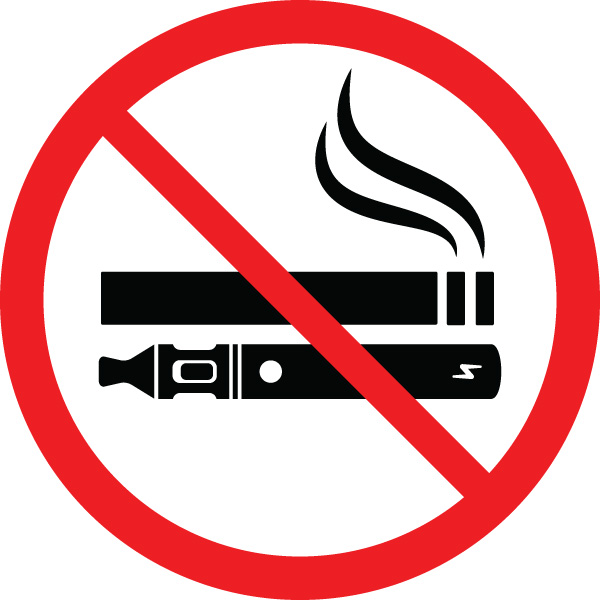
Tobacco and Vaping
There are many tobacco-related products including cigarettes, cigars, hookahs, water pipes, chewing tobacco, and more recently, e-cigarettes (vapes) and nicotine pouches. The common component shared by all of these is the addictive chemical nicotine.
- Smoking is defined as inhaling and exhaling or holding lighted tobacco or cannabis (medical or recreational).
- Vaping is the act of inhaling and exhaling an aerosol produced by a vaping product, such as an electronic cigarette.
Tobacco
Tobacco use is the leading preventable cause of premature death in Canada. Tobacco use burdens Canadian society with $11 billion in health care or indirect economic costs every year.
| Reasons why people smoke |
|
Everyone has their own reasons for smoking. You may:
|
| The traditional use of tobacco |
|
Traditional tobacco is very different from commercial tobacco and plays an important role in Indigenous culture. To Indigenous People, traditional tobacco:
Learn more at About Talk Tobacco. |
I want to quit smoking
Smoking can cause many diseases. Smoking increases the risk of chronic diseases such as chronic obstructive pulmonary disease, hypertension, cardiovascular diseases, and increased risk of cancer. Quitting smoking has health benefits for people of all ages. It lowers your risk for diseases caused by smoking.
We have information and resources to help you, or someone you know, to quit smoking. It can take many attempts. Don't give up if you are not successful the first time.
|
Benefits of quitting smoking |
||||||||||
|
Quitting smoking has short- and long-term benefits to your health:
In addition to your health, there are even more benefits to you when you quit smoking.
|
||||||||||
|
I plan to quit |
||||||||||
|
Make a quit plan. This includes when you’re going to quit, how many cigarettes you will reduce per day, and how you are going to manage cravings. Set a quit date. Make sure you are not under more stress than usual when you pick your quit date. Other factors to include in your quit plan:
You may have a stronger addiction to nicotine if you "need" a cigarette within the first 30 minutes of waking up, and if it is very hard to go more than an hour without a cigarette. Check out these quit plan resources: |
||||||||||
|
I can quit |
||||||||||
|
||||||||||
|
I almost quit |
||||||||||
|
Relapse Some people start smoking again shortly after quitting. You may need several attempts to quit smoking. Side effects such as cravings, withdrawal and weight gain can all make it difficult to quit.
|
||||||||||
|
Community support and resources |
||||||||||
|
Vaping and e-cigarettes
Consider the consequences of vaping.
| What is an electronic cigarette or vape? |
|
| What are the concerns with vaping? |
|
Although e-cigarettes may contain less chemicals than tobacco cigarettes, vaping is not harmless. There is little research on the safety and long-term health risks of vaping. Vaping is known to:
|
| Why do people choose vaping? |
|
Vaping started as a way for adult smokers to quit smoking tobacco and inhaling the harmful chemicals in commercial cigarettes. The most common reasons for youth to try vaping are curiosity, stress relief, social influence and the appeal of flavourings. Misleading marketing, popularity, and discreet use in public spaces can influence youth to try e-cigarettes. Even youth who do not use tobacco are starting to experiment with e-cigarettes believing that they are safe contributing to the alarming rise in youth vaping rates. Get more information on youth and vaping. |
I want to quit vaping
|
Youth |
|
Youth are vaping more and most who do have tried to quit. Quitting vaping is important because many of the negative health effects are not known. Youth report the following reasons for wanting to quit:
There is not one way to quit vaping so each person’s path to quitting will be different. It may take more than one try to quit before becoming successful and that is okay. Helpful links to help yourself or someone else quit vaping:
|
|
Adults and young adults |
|
Vaping and/or smoking as an adult puts your health at risk.
|
|
More information and support services |
|
Smokers' Helpline is a community of quitters for 18 years of age and over, moderated by Smokers’ Helpline quit coaches.
The Youth-VAST program, through CAMH, is for Ontario youth, ages 12 to 21, who struggle with vaping, substance use, and/or technology use.
Talk Tobacco offers culturally appropriate support and information to First Nations, Inuit, Métis, and urban Indigenous communities.
The Expand Project strives to both start and expand conversations around nicotine and tobacco amongst queer and trans young adults 18 to 29. QuashApp a free smoking and vaping cessation program for youth and emerging adults (ages 14 to 30). Mobile app available in the Apple App Store and Google Play Store. Youth Addiction and Concurrent Disorders Service (CAMH)
Links to services
|
Emerging issues
Nicotine pouches
- Small bags that contain nicotine (an addictive chemical), attractive added flavours, and other ingredients.
- Pouches are placed between individual’s gums and cheek where the nicotine is absorbed by the body.
- Do not contain tobacco.
- One pack of 24 nicotine pouches has the same amount of nicotine as two to four packs of cigarettes (40 to 80 cigarettes).
- Can only be legally sold in pharmacies in menthol and mint flavour.
Second-hand smoke and vape
Did you know being around others while they smoke or vape has negative health effects on you?
|
Second-hand smoke |
|
What is second-hand smoke? Second-hand smoke is tobacco smoke inhaled by people who are not actively engaged in smoking and consists of the smoke that a smoker breathes out, as well as the smoke that drifts into the air from the burning end of a cigarette or other smoking device (e.g. cigar, pipe, bidi). What are the numbers? Each year in Canada, 800 non-smokers die from lung cancer and heart disease caused by exposure to second-hand smoke. There are thousands of chemicals in second-hand smoke and at least 70 of these can cause cancer. Did you know?
Risks Second-hand smoke is dangerous and there is no safe level of exposure. Second-hand smoke is linked to:
In children, exposure to second-hand smoke can cause:
Exposure to second-hand smoke has also been linked to childhood cancer (leukemias, lymphomas, brain tumours), onset of asthma, and Sudden Infant Death Syndrome (SIDS). |
|
Second-hand vape |
|
What is second-hand vape? Second-hand vape is the aerosol that is inhaled by people who are not actively engaged in vaping and consists of the aerosol that a person who vapes breathes out while vaping. Risks
|
Tobacco and vape-free living
|
Making your home smoke-free |
||||||
|
When you make your home smoke and vape-free, you protect those who live with you. You also help yourself quit smoking or vaping by reducing the triggers around you. Opening a window or going into another room does not protect your family from second-hand smoke and vapour. Use these tips to make your home smoke-free:
|
||||||
|
Smoke-free apartments, condos and townhomes |
||||||
|
If you live in an apartment, condo, or townhome, you may have second hand smoke or vapour coming into your home from your neighbour’s unit. This is a problem for many people, especially those with asthma, allergies, lung disease, heart disease, or diabetes. For children, this also increases the risk of many health problems. The Smoke-Free Ontario Act protects people from second hand smoke and vapour in public places such as common areas (e.g. hallways, stairwells, elevators, laundry rooms) in apartments and condominiums. Private units in apartments, condos, or townhomes can be made smoke or vape-free. Landlords have the legal right to designate their building as smoke and vape-free housing and a right to protect their property. Learn more about making your apartment, condominium or townhome smoke and vape-free: |
||||||
|
Making your car smoke-free |
||||||
|
When you smoke or vape in the car, everybody in the car is affected. Opening a window does not reduce the effects of second-hand smoke or vapour. It is against the law to smoke or vape inside of a vehicle when there is anyone under the age of 16 present. Use these tips to make your car smoke and vape free:
If you are in the car with young children, turn off the car, step outside and stand where you can see the children to take your smoke or vape break; never leave the car running with children inside. |
||||||
| Third-hand smoke and vapour | ||||||
|
Third-hand smoke and vapour are the residue of toxic chemicals that is left behind after smoking and vaping and clings to surfaces such as:
Third-hand smoke and vapour build up on these surfaces over time and puts infants, children, and pets at a greater risk for exposure than adults. Exposure to third-hand smoke can increase the risk of health problems such as asthma and cancer. You can take the following steps to protect your loved ones from third-hand smoke and vapour:
|
||||||
| Workplaces | ||||||
|
A tobacco and vape-free workplace will not only contribute to a safer and healthier society, but also saves money. Smoke-free environments contribute to increased productivity, better morale, and lower cleaning costs.
|
||||||
| Schools | ||||||
For more information to help students quit smoking or vaping, please visit our Educator's page. |
||||||
| Parents | ||||||
|
Nicotine and other chemicals found in tobacco and vaping products have many harmful effects on the developing brain and bodies of children and teens. Getting support for your child or teen early can help prevent or reduce the harmful effects of smoking and vaping on their body. Parents and other caring adults have a big impact on the health decisions children make, including about smoking and vaping. Even teens say that their parents are a big influence in their lives. Talking to your children about smoking and vaping can play a big part in helping them to be informed and make good choices. Not an experiment parent/caregiver resource Tips for talking to your child or teen about smoking and vaping: Stay connected: Talk early and often with your child about their thoughts about smoking and vaping. Encourage an honest discussion by asking open-ended questions and listening more than you talk. Be positive: Build trust by listening with an open mind. Try not to frighten or lecture your child when talking about smoking or vaping. Focus on safety: Be prepared with facts about smoking and vaping so that you can answer their questions. If there is something that you don’t know the answer to, be honest and use the opportunity to learn together. To learn more about smoking and vaping please visit the tobacco/vaping section. Be supportive: Youth may smoke or vape for different reasons; to fit in or to cope with stress. Create a safe space for your child by being open, non-judgmental, and understanding. Be ready to help your child find healthier coping strategies and ways to deal with peer pressure. Set a positive example: If you smoke or vape be open and honest about why you started and how it affects your health. Try not to smoke or vape in front of your children – the more they see it, the more normal it will seem, and children often do what they see. It’s never too late to quit. Talk to your health care provider or find supports to quit in your community. Talk with your child or teen: For information on how to navigate difficult conversations with youth on nicotine use visit the youth section. More information and services |
| Pregnant women |
|
Smoking and vaping during pregnancy is harmful to you and your baby. When you or someone around you smokes or vapes, the baby smokes and vapes too. Living a smoke and vape-free life is one of the best things you can do for yourself and your baby. Smoking during pregnancy can have many negative effects on the baby and puts your baby at a higher risk for complications such as:
Exposure to second-hand smoke is also very harmful for the developing baby. Second-hand smoke contains all the of same chemicals that are in the smoke that the smoker inhales and can get passed to the baby through the placenta.
Vaping also contains nicotine and other chemicals that are toxic for the developing baby and can impact brain and lung development. Although vaping products may contain fewer harmful chemicals than cigarettes, it is still harmful to you and your baby and it is recommended that women who are pregnant avoid vaping and exposure to second-hand vapour. If you do smoke or vape, it is best to avoid doing so in enclosed spaces such as your home or vehicle and instead go outdoors. Preventing your exposure to second-hand smoke and vapour will also reduce risks to baby. To learn more about quitting smoking or vaping during pregnancy, speak with your health care provider. For more information: |
| Breastfeeding |
|
If you smoke or vape, nicotine and other harmful chemicals can be passed through your breast milk to your baby. It is safer not to smoke or vape or be exposed to second-hand smoke or vapour while you are breastfeeding. However, due to the many benefits of breast milk, breastfeeding is still the best way to feed your baby even if you smoke or vape or are exposed to second-hand smoke or vapour. Lower the risk to your baby by:
If you are interested in learning more about quitting smoking or vaping, please speak with your health care provider. For more information: |
| Youth (ages 12 to 18) |
|
Youth may begin smoking and vaping during their teenage years.
Youth say they vape for many reasons like being curious, wanting to try something new, and to relieve stress. Most youth do not vape to quit smoking. Vaping has long term health effects. Vaping is not a safe or healthy addiction to start. Conversation tools The Brief Conversations Toolkit made by public health experts from Ontario Public Health Units and the Lung Health Foundation can assist in navigating difficult conversations with youth on nicotine use by following these steps:
For more information, resources, and videos on how to have brief conversations visit Brief Conversations Toolkit. Get more information on youth vaping. |
| Young adults (ages 19 to 29) |
|
Young adulthood is a stage of life with many changes such as leaving home for the first time, starting work post-secondary education, and being more independent. This can be a stressful time where young adults start smoking or vaping. The brain develops until age of 25. The harmful effects of nicotine and other chemicals found in tobacco and vape products impact the brain and body in many ways including:
Vaping rates are rising in this group. Young adults who are unhoused, lack access to food, or mental health issues are at a greater risk of harms from smoking and vaping. Early support can help prevent or reduce the harmful effects of smoking and vaping on the brain and body. Learn more about quitting supports. |
| Additional resources and community support |
Smoking, vaping and the law
The Smoke-Free Ontario Act, 2017 (SFOA) bans smoking and vaping of any substance in all enclosed workplaces, enclosed public spaces and other designated places. This is to protect workers and the public from the harmful effects of second-hand smoke and vapour.
The SFOA is enforced by Health Department tobacco enforcement officers who conduct inspections and investigations of public places and workplaces, respond to complaints, and lay charges when necessary. If convicted of smoking or vaping where it is not allowed, you may be charged with an offence and subject to a set fine of $400 up to a maximum of $5,000.
See penalties and fines under the Smoke-Free Ontario Act, 2017
|
SFOA enforcement on school property |
|
The SFOA regulates the smoking of tobacco products, the use of electronic cigarettes to vape any substance, and the smoking of cannabis to protect people of Ontario especially youth, from the harms of tobacco, the potential harms of vapour products, and the harms of second-hand cannabis smoke. Restricting youth access to tobacco and vapour products is an integral part of the SFOA, a comprehensive tobacco control program aimed at preventing children and youth from starting to use tobacco and vapour products. Smoking and vaping laws are enforced on school property.
|
|
Where you can’t smoke or vape in Ontario |
|
You cannot smoke or vape:
|
Smoking and vaping legislation in Durham Region
The Durham Region Smoking and Vaping By-law, regulating smoking and vaping of tobacco, cannabis, vapour products and the smoking of water pipes in enclosed public places and workplaces in Durham Region. This By-law has further restrictions on places where smoking, vaping and cannabis use are prohibited.
The Smoke-Free Ontario Act, 2017 combined with the regional Smoking and Vaping By-law, helps to provide area residents with an increased level of protection from both indoor and outdoor exposure to second-hand smoke and vape in public spaces, as well as protection for employees from exposure in the workplace.
Individuals convicted of an offence under the regional Smoking and Vaping By-law could be subject to a maximum fine of $5,000.
You are protected from second-hand smoke and vape in these extended spaces:
- Smoking or vaping is prohibited inside any hookah/vape lounge and specialty vape stores
- Smoking and vaping is prohibited within nine metres of all public entrances/exits at workplaces and public places
- Smoking and vaping is prohibited within 20 metres of all public park properties in Durham Region
- Smoking and vaping is prohibited on all post-secondary institution property
- Smoking and vaping is prohibited on all municipal property
Durham Region Smoking and Vaping By-law
Submit a complaint
Residents can submit an online complaint or concern to the Health Department about smoking or vaping in public places and workplaces. We also want to hear from you if you can provide information regarding a business selling tobacco or vapour products to youth under the age 19.
Retailers
Tobacco and vapour product retailers have the legal responsibility to ensure that they understand and comply with the requirements under the Smoke-Free Ontario Act, 2017.
- Tobacco/e-cigarette quick age check
- Tobacco/e-cigarette acceptable I.D.
- Tobacco/e-cigarette is a customer 19 sticker
- Smoke-Free Ontario Act, 2017: Guide for retailers
English | French
How the Act affects: Tobacco and vapour product retailers
How the Act affects: Flavoured tobacco products
| Specialty vape store registration |
|
A specialty vape store is a business registered with the local Board of Health that primarily sells vapour products.
A specialty vape store must have vapour products account for at least 85 per cent of its total sales in the previous year. If the retailer has been in operation for less than one year, at least 85 per cent of the retailer's total inventory purchases or sales for that time period must be vapour products. The remaining up to 15 per cent of the store's revenues or inventory would have to be dedicated to other items associated with a vapour product or branded with the name of the specialty vape store or a brand of vapour products. One business name sign may be posted on the exterior of the specialty vape store, but it must not contain additional promotional language (e.g., "Best vape store in town", "vape pens, e-juice sold here"). Guidelines for registration as a specialty vape store How the Act affects: Specialty vape stores |
|
Tobacconist registration |
|
A tobacconist is a business registered with the local board of health that primarily sells specialty tobacco products. This includes tobacco products and accessories (e.g. cigars, pipes, humidors), but does not include cigarettes. A retailer can register as a tobacconist with Durham Region Health Department if the following criteria are met: Specialty tobacco products account for at least 85 per cent of its total sales in the previous year. If the retailer has been in operation for less than one year at least 85 per cent of the retailer's total inventory, purchases or sales during this time period must relate to speciality tobacco products. The remaining up to 15 per cent of the store's revenues or inventory would have to be from cigarettes or other items reasonably associated with a tobacco product and branded with the name of the tobacconist or a brand of tobacco. One business name sign may be posted on the exterior of the tobacconist, but it must not contain additional promotional language (e.g., "Best cigars in town", "Cigars sold here"). Guidelines for registration as a tobacconist How the Act affects: Tobacconists |
|
No smoking, no vaping signs for businesses and retailers |
|
Download signs For retailers
For businesses No smoking, no vaping signs for businesses Request printed signs Durham Region retailers and businesses can request signs from the Health Department by contacting the Durham Health Connection Line. |
Contact Us
Health Department - Durham Health Connection Line
Population Health Division
The Regional Municipality of Durham
605 Rossland Road East
Whitby, Ontario L1N 6A3
Telephone (within regional limits): 311
Telephone: 905-668-2020
Toll-Free: 1-800-841-2729
Email Durham Health Connection Line
Map this location









